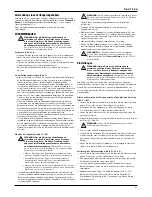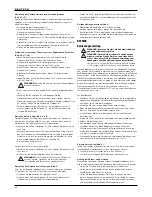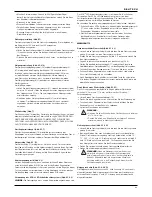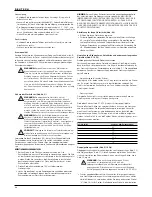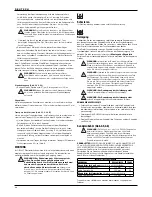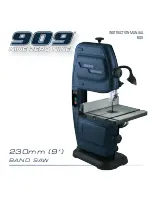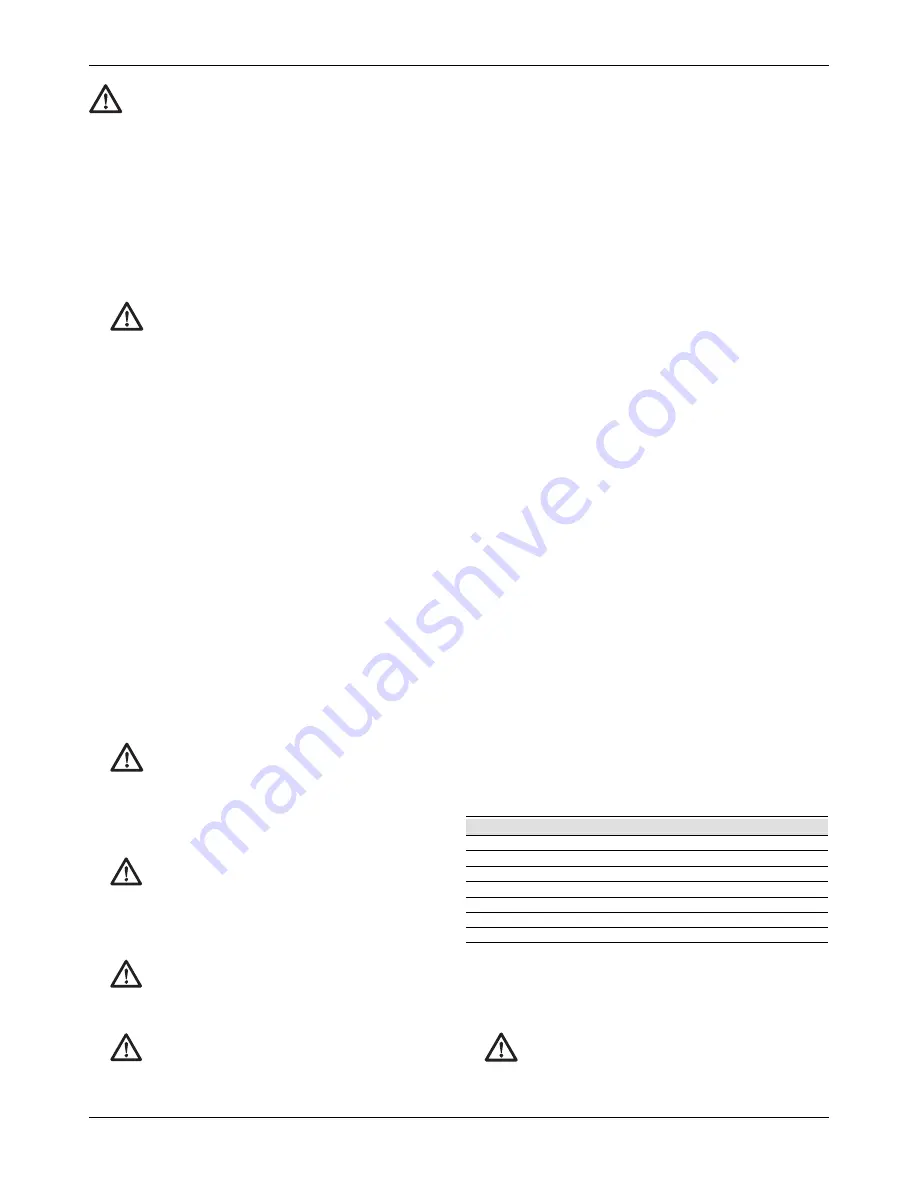
34
WARNING:
• Do not perform sliding cuts on workpieces smaller than
76.2 mm.
• Remember to lock the saw head in the rear position when the
sliding cuts are fi nished.
Mitre cross-cut (fi g. A1 & N)
• Release the mitre lever (4) and depress the mitre latch (5).
• Move the arm left or right to the required angle. The mitre latch will
automatically locate at 10°, 15°, 22.5°, 31.62° and 45° both left and
right. If any intermediate angle is required hold the head fi rmly and lock
by tightening the mitre lever.
• Always ensure that the mitre lever is locked tightly before cutting.
• Proceed as for a vertical straight cross-cut.
WARNING:
When mitring the end of a piece of wood with a
small off-cut, position the wood to ensure that the off-cut is to
the side of the blade with the greater angle to the fence; i.e. left
mitre, off-cut to the right - right mitre, off-cut to the left.
Bevel cuts (fi g. A1, A2 & O)
Bevel angles can be set from 48° left to 48° right and can be cut with the
mitre arm set between zero and a maximum of 45° mitre position right or
left.
Left bevel
• Slide the upper part of the left side fence (3) to the left as far as it will go.
• Loosen the bevel clamp handle (21), lift the bevel latch (20) and set the
bevel as desired.
• The bevel latch automatically locates at 22.5°, 33.85° and 45°. If
any intermediate angle is required, hold the head fi rmly and lock by
tightening the bevel clamp handle (21).
• Proceed as for a vertical straight cross-cut.
Right bevel
• Slide the upper part of the right side fence (8) to the right as far as it will
go.
• Proceed as for a left bevel cut.
Quality of cut
The smoothness of any cut depends on a number of variables, e.g. the
material being cut. When smoothest cuts are desired for moulding and
other precision work, a sharp (60 tooth carbide) blade and a slower,
even cutting rate will produce the desired results.
WARNING:
Ensure that the material does not creep while
cutting; clamp itsecurely in place. Always let the blade come to
a full stopbefore raising the arm. If small fibres of wood still split
out atthe rear of the workpiece, stick a piece of masking tape
on thewood where the cut will be made. Saw through the tape
andcarefully remove tape when finished.
Clamping the workpiece (fi g. A6, U)
WARNING:
A workpiece that is clamped, balanced and secure
before a cut may become unbalanced after a cut is completed.
An unbalanced load may tip the saw or anything the saw is
attached to, such as a table or workbench. When making a cut
that may become unbalanced, properly support the workpiece
and ensure the saw is firmly bolted to a stable surface. Personal
injury may occur.
WARNING:
The clamp foot must remain clamped above the
base of the saw whenever the clamp is used. Always clamp the
workpiece to the base of the saw – not to any other part of the
work area. Ensure the clamp foot is not clamped on the edge of
the base of the saw.
CAUTION:
Always use a work clamp to maintain control and
reduce the risk of personal injury and workpiece damage.
Use the material clamp (30) provided with your saw. The left or right fence
will slide from side to side to aid in clamping. Other aids such as spring
clamps, bar clamps or C-clamps may be appropriate for certain sizes and
shapes of material.
TO INSTALL CLAMP
1. Insert it into the hole behind the fence. The clamp should be facing
toward the back of the mitre saw. The groove on the clamp rod should
be fully inserted into the base. Ensure this groove is fully inserted into
the base of the mitre saw. If the groove is visible, the clamp will not be
secure.
2. Rotate the clamp 180° toward the front of the mitre saw.
3. Loosen the knob to adjust the clamp up or down, then use the fine
adjust knob to firmly clamp the workpiece.
NOTE:
Place the clamp on the opposite side of the base when beveling.
ALWAYS MAKE DRY RUNS (UNPOWERED) BEFORE FINISH CUTS TO
CHECK THE PATH OF THE BLADE. ENSURE THE CLAMP DOES NOT
INTERFERE WITH THE ACTION OF THE SAW OR GUARDS.
Support for long pieces (fi g. A5)
• Always support long pieces.
• For best results, use the extension work support (29) to extend the
table width of your saw (available from your dealer as an option).
Support long workpieces using any convenient means such as
saw-horses or similar devices to keep the ends from dropping.
Cutting picture frames, shadow boxes & other four sided projects
(fi g. P1 & P2)
Trim moulding and other frames
Try a few simple projects using scrap wood until you develop a “feel” for
your saw. Your saw is the perfect tool for mitring corners like the one
shown in fi g. P1. The joint shown has been made using either bevel
adjustment.
- Using bevel adjustment
The bevel for the two boards is adjusted to 45° each, producing a 90° corner.
The mitre arm is locked in the zero position. The wood is positioned with
the broad fl at side against the table and the narrow edge against the fence.
- Using mitre adjustment
The same cut can be made by mitring right and left with the broad surface
against the fence.
The two sketches (fi g. P1 & P2) are for four side objects only. As the
number of sides changes, so do the mitre and bevel angles. The chart
below gives the proper angles for a variety of shapes, assuming that all
sides are of equal length. For a shape that is not shown in the chart,
divide 180° by the number of sides to determine the mitre or bevel angle.
No. of sides
Angle mitre or bevel
4 45°
5 36°
6 30°
7 25.7°
8 22.5°
9 20°
10 18°
Compound mitre (fi g. Q1 & Q2)
A compound mitre is a cut made using a mitre angle (fi g. P2) and a bevel
angle (fi g. P1) at the same time. This is the type of cut used to make
frames or boxes with slanting sides like the one shown in fi g. Q1.
WARNING:
If the cutting angle varies from cut to cut, check
that the bevel clamp knob and the mitre lock knob are securely
tightened. These knobs must be tightened after making any
changes in bevel or mitre (fi g. Q1 & Q2).
E N G L I S H
Summary of Contents for DW717
Page 1: ...DW717 DW717XPS ...
Page 3: ...1 9 7 2 3 20 15 14 16 8 4 5 1 12 11 10 17 A1 A2 19 21 22 18 20 23 24 25 26 13 6 6 ...
Page 4: ...2 22 10 11 24 24 16 25 25 25 25 29 27 C B A5 A6 A3 A4 28 30 ...
Page 5: ...3 37 23 38 39 40 41 37 2 23 14 2 12 14 D1 D2 D3 E1 E2 D4 4 5 42 43 2 37 ...
Page 6: ...4 21 20 47 46 7 45 45 45 F E3 E4 H1 H2 H3 G H4 55 55 51 50 15 3 44 39 61 48 43 44 39 ...
Page 7: ...5 58 1 56 21 57 8 53 54 3 52 54 I1 M K L I2 J O N ...
Page 8: ...6 17 59 60 A P1 P2 Q1 Q2 R S2 64 64 S1 62 T 18 16 30 2 3 1 U ...
Page 142: ...140 ...
Page 143: ...141 ...


